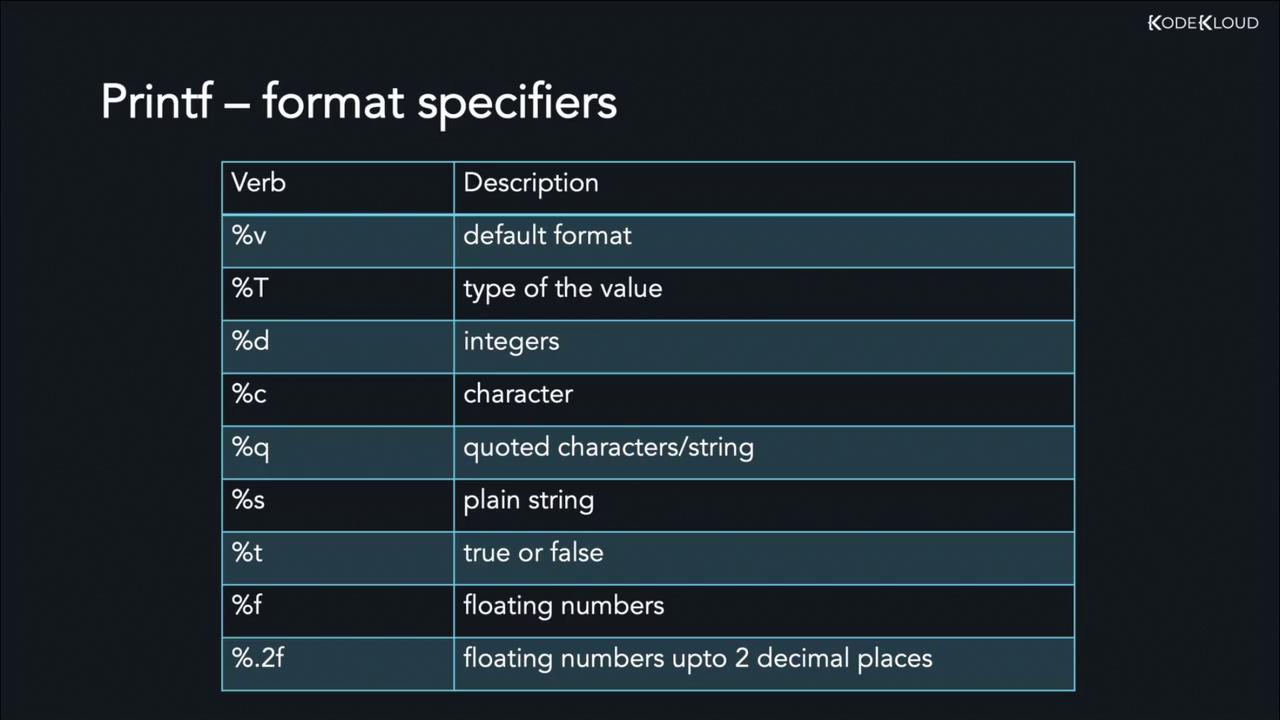Golang
Data Types and Variables
Printing Variables
In this article, you'll learn various methods to print variables in Go (Golang). We will cover printing plain strings, variables, mixing strings and variables, handling newlines, and formatted printing using the fmt package. These techniques lay the foundation for effectively displaying data in your Go applications.
Printing a String
Begin by declaring a package, importing the fmt package, and using its Print function to output a string. For instance, to print "Hello World", use the following code:
package main
import "fmt"
func main() {
fmt.Print("Hello World")
}
Run the program using:
go run main.go
The output will be:
Hello World
Printing a Variable
To print a variable, declare and initialize it, then pass it to fmt.Print. For example, the code below declares a variable named city with a value of "Kolkata" and prints it:
package main
import "fmt"
func main() {
var city string = "Kolkata"
fmt.Print(city)
}
Running this code displays the variable's value.
Printing Variables and Strings Together
Often, you need to combine static text with variable values. Here's an example where two variables, name and user, are printed alongside string literals:
package main
import "fmt"
func main() {
var name string = "KodeKloud"
var user string = "Harry"
fmt.Print("Welcome to ", name, ", ", user)
}
Executing the program results in:
Welcome to KodeKloud, Harry
Note
Remember that the fmt.Print function does not append a newline by default. When printing multiple items consecutively, they will appear without any line breaks.
For example, printing two variables without a newline:
package main
import "fmt"
func main() {
var name string = "KodeKloud"
var user string = "Harry"
fmt.Print(name)
fmt.Print(user)
}
Produces this output:
KodeKloudHarry
Adding Newlines with "\n"
To create line breaks, include the newline character (\n) in your string expressions. The following example demonstrates how to print variables on separate lines:
package main
import "fmt"
func main() {
var name string = "KodeKLOUD"
var user string = "Harry"
fmt.Print(name, "\n")
fmt.Print(user)
}
The output will be:
KodeKLOUD
Harry
Note
The newline character (\n) is interpreted as a line break rather than printed literally.
Automatic Newlines with fmt.Println
For convenience, the fmt package offers the Println function, which appends a newline automatically after printing each argument:
package main
import "fmt"
func main() {
var name string = "KodeKloud"
var user string = "Harry"
fmt.Println(name)
fmt.Println(user)
}
Running this code produces:
KodeKloud
Harry
Formatted Printing Using fmt.Printf
When managing multiple arguments, formatted printing can simplify your code. The fmt.Printf function lets you embed format specifiers within a template string to control the output of each variable.
What is String Formatting?
String formatting allows you to integrate variables within a predefined text template. For example:
fmt.Printf("Template string %s", object)
Here, the %s specifier indicates where a string variable should be inserted.
Common Format Specifiers
Below are some frequently used format specifiers in Go:
| Format Specifier | Description |
|---|---|
%v | Default format for the value |
%T | Data type of the value |
%d | Decimal integer |
%c | Character |
%q | String enclosed in quotes |
%t | Boolean value |
%f | Floating-point number |
Example: Printing a String with %v
package main
import "fmt"
func main() {
var name string = "KodeKloud"
fmt.Printf("Nice to see you here, at %v", name)
}
The output will be:
Nice to see you here, at KodeKloud
Example: Printing an Integer with %d
package main
import "fmt"
func main() {
var grades int = 42
fmt.Printf("Marks: %d", grades)
}
This code produces:
Marks: 42
Combining Format Specifiers
You can combine multiple format specifiers in a single Printf call. For instance, the following example integrates a string and an integer:
package main
import "fmt"
func main() {
var name string = "Joe"
var score int = 78
fmt.Printf("Hey, %v! You have scored %d/100 in Physics", name, score)
}
The output appears as:
Hey, Joe! You have scored 78/100 in Physics
Summary of Format Specifiers
Below is an image that summarizes commonly used fmt.Printf format specifiers in Go:

That concludes our guide on printing variables in Go. In the next lesson, we will delve into more advanced topics to further enhance your Go programming skills.
Watch Video
Watch video content